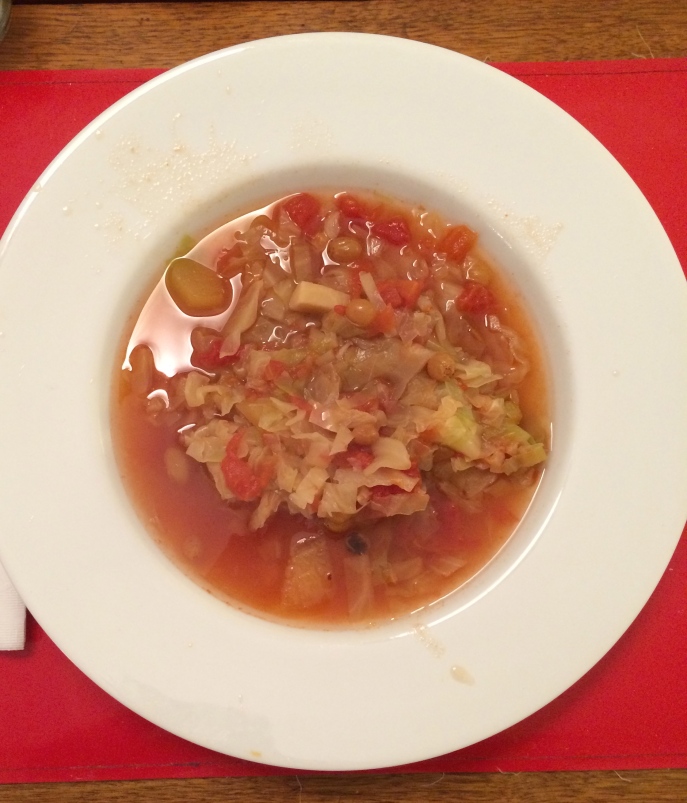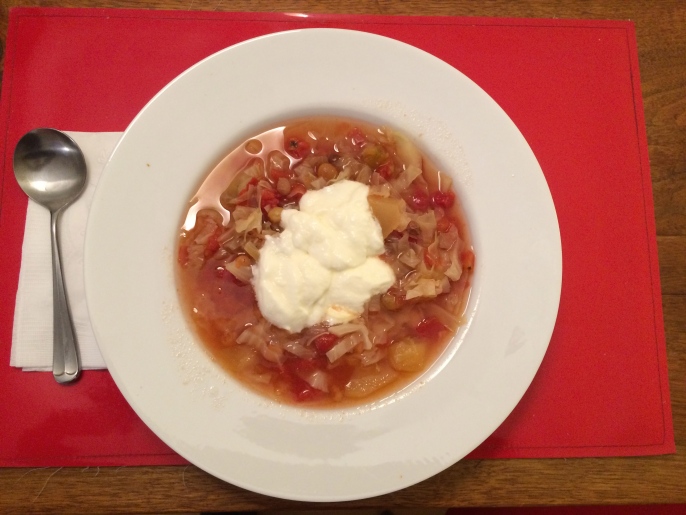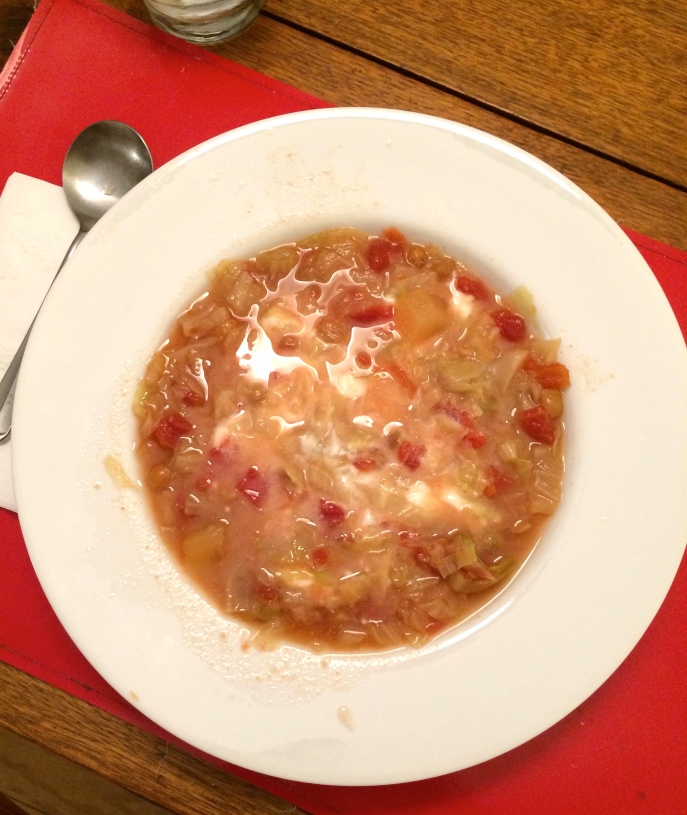Don’t worry; the soup in this picture was made just a few hours ago. It’s the recipe that’s historic. I was aiming for the cabbage soup my Russian mother used to serve when I was a little girl. Since she probably learned how to make it from her mother, that would put the recipe back to the last years of the nineteenth century. (Whether or not my grandmother acquired it from my great-grandmother, thereby making the recipe even older, is purely speculative.)
Oddly, my mother always called this historic soup “borscht” even though there were no beets in it. Whatever. It tasted very good. Competitive to the end, she managed with sly evasions never to give me the recipe. Which may have been just as well, because I recall that what she did was a complicated all-day affair involving a huge pot and “goluptsi” (little birds) cooked in the soup. And complicated all-day cooking is not for me, irrespective of the taste thrill at the end. What are “goluptsi?” Big cabbage leaves wrapped around a seasoned combination of chopped meat and rice. The soup would be the opener, the little birds the main course.
So the recipe I’m referring to here is not exactly my mother’s (or grandmother’s). However, something that looked as if it would taste very much like their soup eventually showed up in “EAT!” — a cookbook published by the Parents and Teachers Association of Public School 166 (Manhattan) in March 1975. I was a P.S. 199 parent of two boys at that time and therefore felt obliged to buy “EAT!” (Especially as I had two recipes included in it myself.)
The soup in “EAT!” was called “Reena Kondo’s Cabbage Soup.” The contributor of this recipe, known to us all as Miss Kondo, had been my younger son’s kindergarten teacher the year before. She was of Polish-Jewish descent, and I am quite certain the soup recipe had come to America one or two generations prior to reaching her, probably also through the maternal line, thus escaping annihilation in the Warsaw ghetto.
Instead of goluptsi, Miss Kondo’s mother and/or grandmother had added a few pieces of cut up beef and carrots. I have omitted them. I have no recollection of cooked carrots in any maternal soups of my childhood, and my mother would never have wasted a good piece of beef by boiling it in soup. However, stripped of these decadent refinements, the following reconstructed recipe will taste remarkably similar to what I was lapping up at the kitchen table in Washington Heights in the 1930’s. It makes at least three suppers-in-a-bowl for two adults as a main course. Easy-peasy too. And remember: cruciferous vegetables are very good for you.
[P.S. If you can’t find sour salt anywhere, squeeze four or five lemons, salt the lemon juice heavily, and add the salted juice to the pot.]
RECONSTRUCTED CABBAGE SOUP RECIPE, CIRCA 1900
1 head of white cabbage
2 14 oz. cans diced tomatoes
handful (or several handfuls) of white raisins
several pieces of sour salt (to taste)
Regulär table salt (to taste)
Honey and/or brown sugar (to taste)
2 apples, peeled and cut into eighths
Cut the cabbage into small pieces or shred it. In sizeable pot, cover the shredded cabbage with cold water and add all the remaining ingredients except the apples, which should be put in towards the end. Cooking time is about two hours, but after an hour or so begin tasting and adjusting the salt, lemon juice (if you’re using it) and sweetener till you achieve a sweet/sour taste you like.
I don’t know about Reena Kondo, but my mother always served it with a big blob of sour cream on top. I use yogurt. (Goat’s milk yogurt, to be precise, but we’re peculiar. My mother didn’t know about goat’s milk yogurt.)
At the table, mix with your soup spoon. Serve with black bread, French bread, no bread.
If you were to make it tomorrow (Thursday), you’d be all set through Saturday. Who wants to be in the kitchen too often, now that it’s (nearly) spring?





Looks similar to the cabbage soup that was popular when I was young only it included potatoes and was minus the raisins and sour salt. I love anything with cabbage in it. Unfortunately I married a man who does not. Of course I could split it with my brother. He and his wife would love it.
LikeLike
Yours sounds very tasty too. Maybe we should swap recipes.
LikeLiked by 1 person
Yes, a good soup goes from generation to generation. Hopefully the Mishkin gabbage soup recipe will be carried through into the future with pride and much joy.
LikeLiked by 1 person
Alas, I don’t believe it will. Recipes go from mother to daughter; I have only sons. However, perhaps my cabbage soup will live on in the kitchen of some TGOB follower who has daughters to carry on with making it.
LikeLike
Well, I am a son last time I looked, and have carried my dad’s recipe for pancakes and am hopeful one of my grandsons will carry it into the future as well.
My epitaph; Here rests a man who made good pancakes. ( keep off the grass)
LikeLike
Mothers to daughters, fathers to sons. The father of my sons didn’t cook. So what else is new? It’s hard to get the last word with me, Gerard. Especially when your response doesn’t follow from what went before.
LikeLike
Che?
I thought your remark about ‘only having sons’ implied that cooking or recipes excluded males by virtue of their sex.
I thought to add a voice of mild and mirthful protest.
LikeLike
What is sour salt? I have lived in the South all my life. We are all about salt here (unfortunately), but I’ve not heard of a sour version.
LikeLike
Sour salt is citric acid in crystal form. The fine crystals give a puckery tartness, like lemon, to foods. It is a common ingredient in Russian and Jewish cooking. People on low sodium diets also find this spice gives some of the same type of taste as salt. The most common use for citric acid is in canning. It helps preserve and prevent discoloration. But it is also sometimes used in homemade lemonade mixes. I can’t speak for supermarkets in the South, but a quick search online shows sour salt can be purchased from various spice houses, from Walmart and from Amazon.
LikeLike
Thank you, Nina! I am certainly familiar with citric acid. I’m seriously considering making the soup; we’re still having chilly days. But I like soup in any weather. Anyway, I’m intrigued by the ingredients, and I like the way it looks in your photos. Thanks for those!
LikeLike
Sour salt… I didn’t know what it was called, but I have it! I’ve always just called it ‘citrus crystals’. I found it one year in a Turkish street market, whilst I was on holiday and now I buy some whenever I’m back there and see it. They scoop it into bags from vast buckets or tubs. I use it for flavouring when I don’t have fresh lemons around. I’ve never seen it on sale in the U.K, though that doesn’t mean it’s not sold here, more that I may be unobservant. Doubtless one will find it at speciality/Jewish/Eastern European/Turkish shops. Thank you for giving it a name for me!
LikeLiked by 1 person
Julie, see my reply to Mary Crawford as to buying it online, if you don’t get back to Turkey soon enough!
LikeLiked by 1 person
Ah, this soup is very popular among my Russian friends. And yes, it’s called Borsht too. There are a number of different variations of Borsht.
LikeLiked by 1 person
And is it also popular with you, Shimon? 😉
LikeLike
Yes, I like it too. But it’s not something I would either cook myself, or order in a restaurant.
LikeLike
Well then I wouldn’t serve it if you ever came to visit!
LikeLike
I can ‘taste’ the last of winter in your sour salty soup… 🙂
and am all for minimizing time spent in the kitchen xxx
LikeLiked by 1 person
Actually it’s sweet-sour, not salty — believe it or not. (Apples, raisins, honey.) You might try it, even in Saudi, if the ingredients exist there. It’s not so wintry. For all I know, it might even be good cold, although I haven’t ever tried that.
LikeLiked by 1 person
Hot is where soup it is at… even in the heat of summer… 🙂 I do love cabbage…
thou would prefer a salty variation… to the sweet & sour!
Two Thumbs Up on the goat cheese yoghurt topping… yumyum… 🙂
LikeLike
Goat milk yogurt. Although you can also put goat cheese on the black bread that goes with the yogurty soup, I suppose.
LikeLike
What a difference a ‘word’ can make!
LikeLike
I, too, have a cabbage soup recipe handed down from my elders, but this one sounds so interesting with the raisins, apples, and sour salt that I’m going to have to try it. It’s alternating rain with snow here today, so it will be a good day for soup.
LikeLiked by 1 person
How exciting that someone is actually going to make it! You can adjust it to your own taste. I hope you like it! 🙂
LikeLike
Nina, it took a couple of weeks but my wife made this delicious recipe today. I haven’t tasted it yet, but its aroma is driving me crazy as I sit at my computer. Thank you for posting it!
LikeLiked by 1 person
I hope it’s to your liking once it reaches your soup bowl. There’s going to be a lot of it!
LikeLike